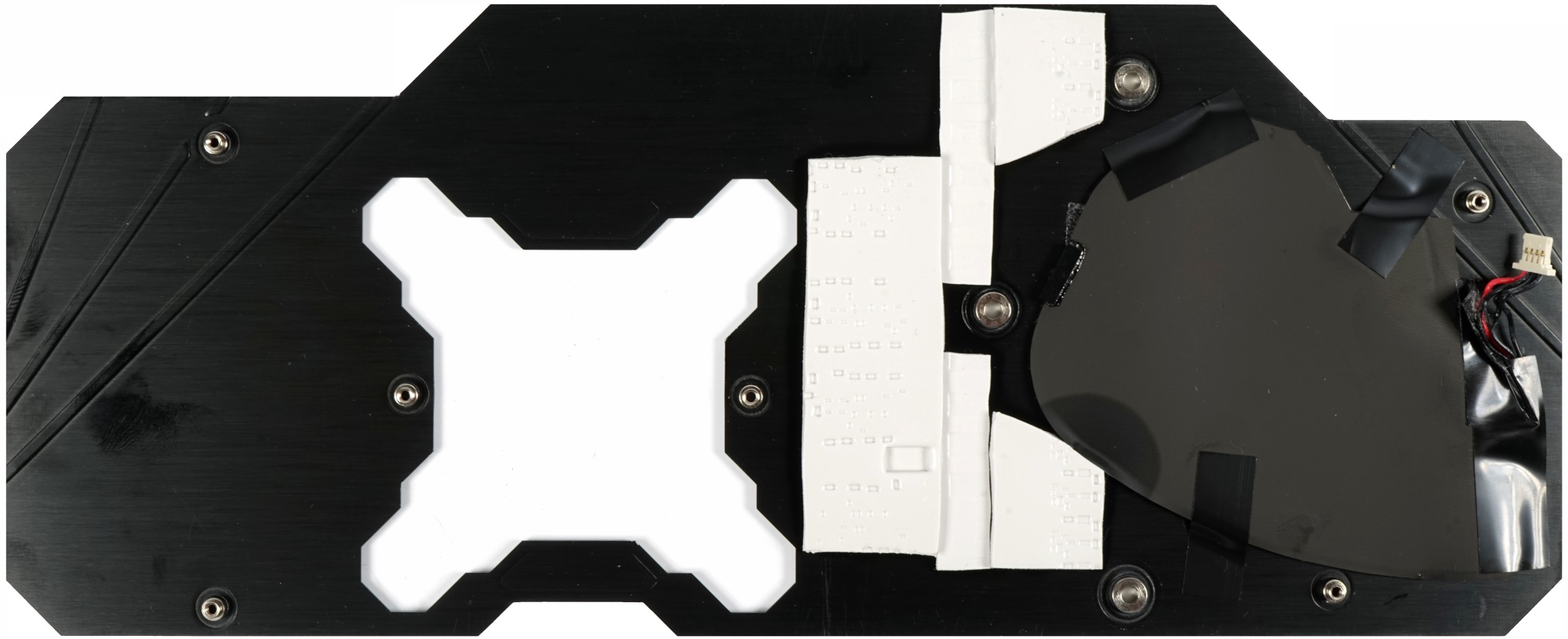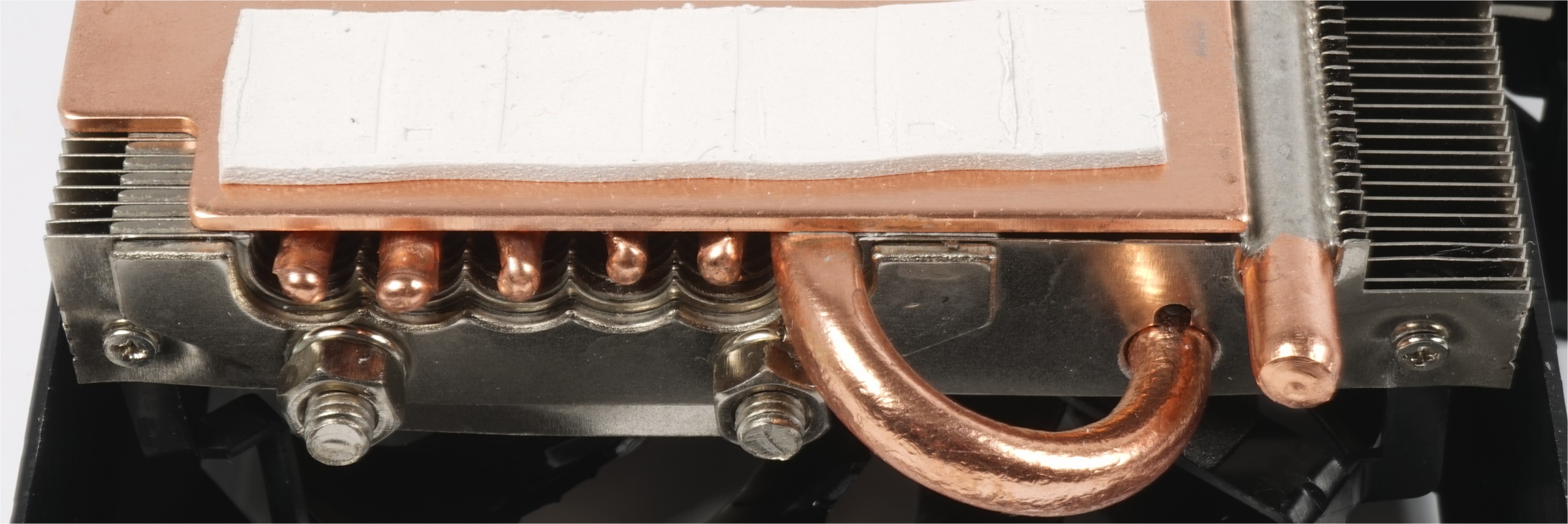Aorus GTX 1080 Ti Xtreme Edition 11G Review
Why you can trust Tom's Hardware
Board & Cooling
Board & Cooling
Gigabyte employs a modified PCB design to work better with its new cooler. The result is clearly quite dense, but components like the chokes, capacitors, and voltage regulation circuitry are lined up in neat rows, one below the other.
The GPU uses a total of six real phases, enabled by uPI Semiconductor's uP9511 eight-phase buck controller. With one uP1911 per phase, this card uses a special phase doubler and gate driver to communicate with a total of 12 control circuits. This means that there are a total of 12 individual voltage converter circuits, two of which are always working in parallel.


Twelve ON Semiconductor (formerly Fairchild) FDMF6823C XS DrMOS modules integrate a gate driver, the high- and low-side MOSFETs, and a Schottky diode. Given the linear arrangement of these 6x6mm packages on the board, Gigabyte achieves a nice spatial distribution of hot-spots under its heat sink.
The polymer capacitors that Gigabyte uses are clever as well. Not only do they reduce overall height, but they also create a flat surface that can be exploited for cooling. There's a row of the same caps on the board's back side, facilitating the use of a thinner thermal pad, since the PCB and backplate are closer together.


Foxconn's encapsulated ferrite core chokes are a mid-range choice, though in this case they aren't completely inaudible. They're used on the GeForce GTX 1080 Ti Xtreme Edition 11G in two different sizes and inductance values.
A total of 11 Micron MT58K256M321JA-110 GDDR5X ICs are organized around the GP102 processor. They operate at 11 Gb/s data rates, which helps compensate for the missing 32-bit memory controller compared to Titan X. We asked Micron to speculate why Nvidia didn't use the 12 Gb/s MT58K256M321JA-120 modules advertised in its datasheet, and the company mentioned they aren't widely available yet, despite appearing in its catalog. Because Nvidia sells its GPU and the memory in a bundle, Gigabyte has very little room to innovate in this regard.


A uP1666 two-phase buck controller is responsible for supplying the memory's voltage. In contrast to what it uses for the GPU's power supply, Gigabyte goes with ON Semiconductor (Fairchild) FDMS3604S PowerTrench dual N-channel MOSFETs for the GDDR5X. Heat from these isn't dissipated by the special VRM sink, but rather through contact with the card's finned cooler. Here, too, the VRM and chokes are cooled.
Get Tom's Hardware's best news and in-depth reviews, straight to your inbox.


Current monitoring is handled by a triple-channel Texas Instruments INA3221.


Another component that stands out is the 32-bit ARM Cortex-M0+ processor made by Holtek, which Gigabyte uses to control the RGB lighting effects.


This card's complement of display outputs is enabled by two Pericom Semiconductor PI3WVR12412 multi-standard video switches, supporting four high-speed lanes each.
Around back, we observe the same neat organization of components ideally suited for backplate cooling. Speaking of...
Inside Gigabyte's Cooler
The backplate isn't just aesthetic in nature, and its purpose isn't limited to adding structural rigidity. Rather, it helps with passive cooling. There's also a film for spreading the RGB diode's light through Gigabyte's Aorus logo.
A recess directly behind the GPU package is reserved for a small copper plate, which has a thermal pad attached to it and is screwed into the processor's heat sink. Gigabyte's marketing is unfortunately a little misleading when it comes to the "Copper Back Plate." You see, the metal piece is deliberately detached from the backplate, which heats up to around 80°C, while GP102 stays a lot cooler.
The copper plate doesn't cool the GPU itself. Instead, it draws heat from the chip's package. The rest of the plate helps with other surface-mount components back there. What looks like a single piece in Gigabyte's pictures is really a dual-zone solution of sorts. In any case, the implementation works well, as we'll see in our thermal testing.
Around front, the main cooler is divided into two parts. A massive copper sink dissipates heat from the GPU to five 8mm heat pipes and a somewhat hidden 6mm pipe made from composite material.
A VRM sink cools the MOSFETs, chokes, and polymer capacitors. Because all of those components sport different dimensions, we end up with a multi-height solution that's implemented in exemplary fashion:
The GPU's massive copper sink is equally compelling because it also serves to cool the memory modules. As we've seen Gigabyte do in the past with some of its Windforce coolers, the company plays it safe with threaded rods and nuts to keep the cooler together.
Three somewhat overlapping fans form what Gigabyte refers to as its Windforce Stack Cooling System. The 100mm fans are equipped with 11 rotor blades each. Their moderate angle suggests optimization for moving lots of air in a turbulent manner, rather than applying pure static pressure. We know from past experience that one centered, counter-rotating fan can work well.
MORE: Best Graphics Cards
MORE: Desktop GPU Performance Hierarchy Table
MORE: All Graphics Content

Igor Wallossek wrote a wide variety of hardware articles for Tom's Hardware, with a strong focus on technical analysis and in-depth reviews. His contributions have spanned a broad spectrum of PC components, including GPUs, CPUs, workstations, and PC builds. His insightful articles provide readers with detailed knowledge to make informed decisions in the ever-evolving tech landscape
-
drwho1 I wait till this cards drop under $300...Reply
Although by then I might want "that other new one" .... -
Bloody Chainsaw Correction. In the specs chart, the Titan's memory bus is listed as 38-bit. Should be 384.Reply -
Kevin-M At that absurd price point you would think there would be more generosity than the inclusion of one of the most common elements on the planet! Thanks but no thanks, I will remain a smart shopper and wait until the price point comes down to a realistic one!Reply -
FormatC Expensive is relative. Mostly all non-smokers have money enough. It is the question, which priority you set. :)Reply -
FormatC If I get one as sample, yes. But closed loop isn't a solution. This are more or less toys.Reply -
TMRichard I must say I think I got a Golden Sample then, my card stays at a stable 2012MHz GPU clock under 65C with fans @ 75% Just waiting on EK to get their block ready so I can add it to my loop!Reply -
FormatC As I wrote in my review - it is a pure lotto. The test sample is running with GPU- und VRM-Waterblock with the AB Extreme and 1.093 Volts at 20°C (chiller) stable 2166 MHz. Other cards neets 1.2 Volts (I have a NO2 BIOS from another card) to crack the 2100 MHz barrier stable. If you buy a card, you get no warranty which GPU quality you get.Reply







